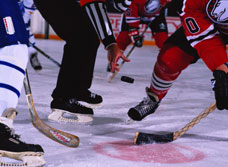 Teaching players to anticipate body-checks may reduce the youth ice hockey concussion risk, say the authors of a first-of-its-kind study of head impact severity among youth ice hockey players (1).
Teaching players to anticipate body-checks may reduce the youth ice hockey concussion risk, say the authors of a first-of-its-kind study of head impact severity among youth ice hockey players (1).
The study focused on body position prior to collision (good anticipation, poor anticipation, and unanticipated), collision location (open-ice or along the boards), and the magnitude of rotational and linear forces to the head sustained in collisions. Sixteen male, Bantam-level ice hockey players wore standard helmets fitted with special sensors, which sent data through a telemetry link.
The researchers found open ice collisions resulted in a statistically significant increase in forces to the head compared to collisions along the boards. Most importantly, players in the "ready" position who anticipated collisions, e.g. those whose knees and trunk were flexed with feet shoulder-width apart, who used their legs to drive their shoulders through the body check - suffered significantly less severe impacts to their head during collisions.
Key recommendations
Coaches.
- Youth athletes participating in collision sports, such as hockey, are at particular risk for concussions. Skill development is often limited, because parent volunteers frequently serve as coaches and lack the expertise necessary to educate athletes on proper collision techniques.
- Coaches should possess the necessary training and certification to ensure safe player development. Coaches across all age levels, competition divisions, and player genders can play a significant role in teach young hockey players to anticipate collisions more effectively.
- Coaches should spend time during practices educating players on how to deliver and receive body collisions in all areas of the ice, including along the boards and in open ice.
- Until further research suggests better ways to reduce mild traumatic brain injury (MTBI) (e.g. concussions), players should continue to be taught the "ready" position and to "skate through the body check", as encouraged by USA Hockey and has long been taught by coaches to young players in the United States and other countries.
- Coaches should practice game-related drills with full contact to help players to adapt to constantly changing conditions during game play, including "small games" drills, which emphasize high speed, quick movements, and game-related tasks (e.g. passing, shooting, and checking) in small, confined spaces (i.e. corner of the rink). Such drills are "excellent at forcing athletes to play with a heightened sense of awareness that allows them to anticipate incoming body collisions.
Game Officials:
- Need to immediately and severely penalize any player who takes advantage of opponents in susceptible, vulnerable (i.e. "defenseless") positions to deliver unsuspected checks.
Parents, Coaches, and Medical Professionals:
- Need to work together to create an environment for young athletes that supports the reporting of concussions and the safe concussion management.
Serious public health problem
The Centers for Disease Control and Prevention (CDC) has labeled traumatic brain injury (TBI) a serious public health problem in the United States. Children under the age of 15 represent up to 40% of the 1.1 million TBIs that result in emergency room visits each year. An alarming number go unreported. As many as 10% of high school hockey players sustain concussions during regular season play; concussion rates during tournament play (from 10.7 to 23.1 cases per 1000 player-hours) is markedly higher.
In a recent Canadian study (2) 11- and 12-year-old who played on Pee-Wee teamswhere body checking was allowed were three times more likely to suffer aconcussion or other severe injuries than those who played in non-checking leagues.
Change is happening
In 2011, USA Hockey approved a ban on body checking before the age of 13, moving up the age at which body checks are allowed by two years (the previous rule permitted body checking in the Pee Wee Division, comprising ages eleven and twelve). A leading concussion expert, Dr. Robert Cantu (3), and the American Academy of Pediatrics, go further, recommending that checking be banned in youth hockey until children reach the age of 14 or 15 respectively.
Sources: "WinterMeetings Prove Productive" USA Hockey (accessed February 3, 2011); Duhatschek E, " USA Hockey considers banning bodychecking for youth players" Toronto Globe and Mail (February 1, 2011) (accessed February 3, 2011).
Footnotes:
1. Mihalik J, Blackburn JT, Greenwald RM., Cantu RC, Marshall SW, Guskiewicz KM. Collision Type and Player Anticipation Affect Head Impact Severity Among Youth Ice Hockey Players. Pediatrics 2010;125(6): e1394-e1401.
2. Emery CA. Risk of Injury Associated with Body Checking Among Youth Ice Hockey Players. J. Am. Med. Assn 2010;22: 2265-2272.
3. Cantu R with Hyman M. Concussions and Our Kids: America's Leading Expert on How To Protect Young Athletes and Keep Sports Safe (Houghton Mifflin Harcourt 2012).
Updated March 2, 2013








